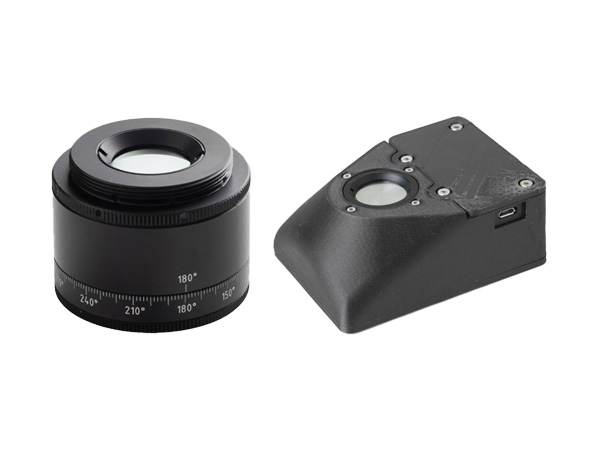
Two specifically structured DOEs are cascaded to obtain various optical elements like lenses, axicons or spiral phase plates. Their optical power is continuously adjustable, simply by rotating the DOEs with respect to each other.
Two specifically structured DOEs are cascaded to obtain various optical elements like lenses, axicons or spiral phase plates. Their optical power is continuously adjustable, simply by rotating the DOEs with respect to each other.
Flexible lens material with low fabrication costs & high power applications
Focal spot stays on optical axis
Compact design (thin and lightweight)
Scalable in size, wavelength and power
Diffraction limited resolution (monochromatic light)
Continuous, simple and exact variation of optical properties within a wide range (e.g. D= ±25 dpt)
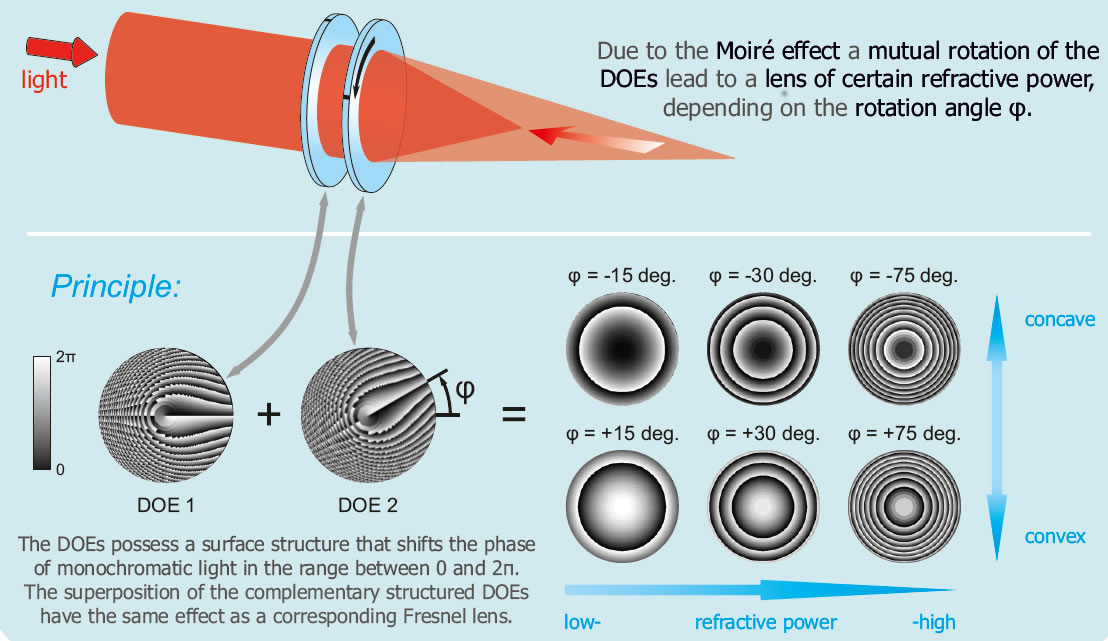
With the Moiré lens a laser beam can be variably focused or objects at variable distance can be imaged sharply. By rotating two DOES (Diffractive Optical Element) against each other, the focal length of the lens changes.
Our tunable axicons make it easy to create high-quality Bessel-like beams. The output parameters of the beam can be tuned by rotating two DOES (Diffractive Optical Element) against each other.
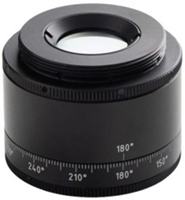
The Moire lens is an innovation in the field of focus tunable lenses. It shows some useful advantages compared to other lenses:
ready for high power applications
its focal spot stays on optical axis
compact design (thin and lightweight)
scalable in size; wavelength and power
diffraction limited resolution (monochromatic light)
continuous-, simple- and exact variation of optical properties within a wide range (e.g. D = ± 25 dpt)
A combination of two Moire lenses can be used to create a variable magnification lens. It represents the potentially most compact zoom optics (especially suitable for smartphone- or thermal-cameras).
Through special DOE design it is possible to produce tunable optical phase shifters. The same principle can be used to generate helical wavefronts (OAM). This beam resembles a corkscrew, with propagation of the wavefront.
By turning the DOE’s against each other, phase shifters and helical beam converters can be tuned easily.
From UV/VIS to IR to Terahertz radiation: For each wavelength the optimal substrate is selected for our customers. All components can be produced with apertures up to 25 mm.
Imaging: lightweight & compact zoom optics for cameras, mobile phones, adjustable eyeglasses, human eye like imaging systems
High Power: laser-engraving, -marking & -cutting, scan heads for high power applications
Beam projection: adjustable illumination systems, lamps & headlights, varifocal automotive lighting, scanners, projectors, printers, etc.
Laboratory equipment: adjustable multipurpose devices for optical prototyping, etc.
Scientific and front-end: laser beam shaping & modulation, production of doughnut beams in optical tweezers & interferometers, etc.
Further applications: thermography, infrared imaging, applications for terahertz radiation, varifocal ultra-sound lenses
In summary,: special high-end applications as well as numerous low-end mass products. Offset optical power can be implemented, optical efficiency up to 90%, chromatic aberrations computationally reducible, combination with “standard” optics (e.g. glass lenses) permits compensation of dispersion effects.
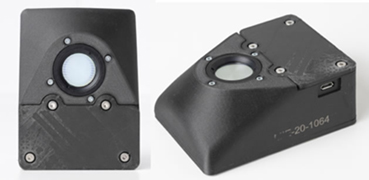
Optical specifications:
Design wavelength: 1064 nm
Focal tuning length: -75 to infinity to +75 mm
Optical power tuning range: -13.2 to +13.2 Dpt.
Substrate: Fused silica
Polarization: preserving
Lens type: convex to concave
Optinal AR coating: 1064 nm
Mechanical specifications:
Length: 98 mm
Width: 73 mm
Height: 38 mm
Mass: 250 g
Clear aperture: 20 mm
Operational specifications:
Temperature 15 to 40oC
Humidity < 80 %R.H (at 31oC).
Maximum altitude 2000 m
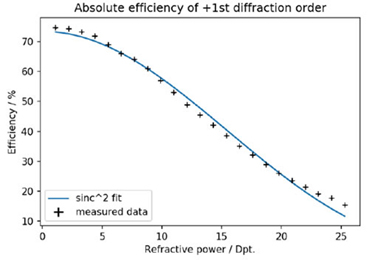 Performance:
Performance:
Travel 360o
Maximum speed: 430 o/sec
Bidirectional repeatablility: 0.05 o
Homing repeatability: 0.25 o
Bidirectional accuracy: 0.4 o
Backlash: 0.013 o
Encoder resolution: 143360 counts/rev
Relative magnetic encode: 0.0025 o/count
Minimum incremental motion: 0.002 o
Minimum holding torque: 0.01 Nm
Axis wobble: 0.014 o
Maximum total load: 50g
Minimum lifetime: > 600000 revolutions
Electrical specifications:
Motor type: Elliptec resonant piezo
DC voltage input: 4.5 to 5.5 V
Typical current consumption (during movement): 800 mA
Typical current consumption: (during standby): 50 mA
Communications:
Bus: Multi-Drop 3.3 V/5 V TTL RS232
Connector on rotation stage board: Picoflex R Connectors on interface board: Picoflex, Micro USB, DC Jack [6.3mm OD (GND), 2.1mm ID (+5V)]
Speed: 9600 baud
Data length (1 stop bit, no parity): 8 bit
Protocol data format: ASCII HEX
Module address and command format: Mnemonic character
 Optical specifications:
Optical specifications:
Design wavelength: 532 nm
Focal tuning length: -75 to infinity to +75 mm
Optical power tuning range: -13.2 to +13.2 Dpt.
Substrate: Fused silica
Polarization: preserving
Lens type: convex to concave
Optional AR coating: 400 to 700 nm
Mechanical specifications:
Case diameter: 32 mm
Case thickness: 26 mm
Mass: 50 g
Clear aperture: 10 mm
Tuning range: continuous
Mounting: thread C-mount
SM1 adapter: yes
Operational specifications:
Temperature: 15 to 40oC
Humidity: 20 to 90 %R.H.
Imaging: lightweight & compact zoom optics for cameras, mobile phones or microscopes, adjustable eyeglasses, human eye like imaging systems
High Power: laser-engraving, -marking & -cutting, scan heads for high power applications
Beam projection: adjustable illumination systems, lamps & head lights, varifocal automotive lighting, scanners, projectors, printers, etc.
Laboratory equipment: adjustable multipurpose devices for optical prototyping, etc.
Scientific and front-end: laser beam shaping & modulation, production of doughnut beams in optical tweezers & interferometers, etc.
Further applications: thermography, infrared imaging, applications for terahertz radiation, varifocal ultra-sound lenses
In summary, special high-end applications as well as numerous low-end mass products. Offset optical power can be implemented, optical efficiency up to 90%, chromatic aberrations computationally reducible, combination with “standard” optics (e.g. glass lenses) permits compensation of dispersion effects.
Optical efficiency up to 90% : Due to its high efficiency, the lens can also be used for high-power lasers (cutting, engraving, etc.).
Compact and lightweight design : The lens is much more compact than conventional optics and can also be used where little space is available.
Large optical power range: Continuous -, simple- and exact variation of optical properties within a wide range (e.g. D = ± 25 dpt).
Tunable Lens
The Moiré Lens enables dynamical focusing. Applications cover
Autofocus or zoom optics for mini cameras in smartphones or drones as well as infrared cameras
Volumetric imaging and 3D-laser processing
Tunable lens for automotive industry, barcode scanning and terahertz applications
Varifocal lens for ophthalmology
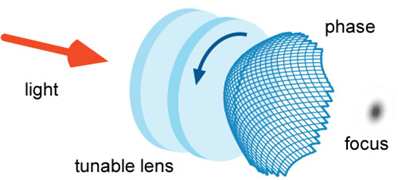
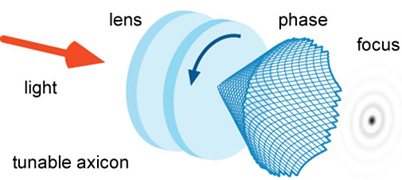
Tunable Axicon
Generate a tunable axicon with the Moiré Lens to dynamically modulate self-healing beams. Applications cover:
Dynamical trapping of micro meter sized structures like cells
Generation of variable self-healing beams or light rings in laser processing and drilling
Adapting depth of field in imaging processes
Dynamic beam modulation in laser surgery
Tunable Phase Shifter
The Moiré Lens principle enables the realization of an infinity phase shifter. Applications cover:
Frequency shifter in high precision spectroscopy
Phase control in interferometry
Optical coherence tomography
Atom trapping and quantum manipulation
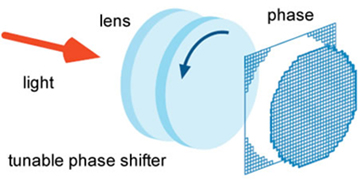
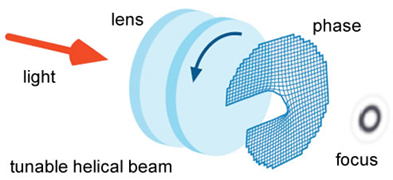
Tunable Helical Beam
With the Moiré Lens the steepness of a staircase-like phase front can be adjusted to produce a ring focus of variable diameter. Applications cover:
Trapping and rotating micro meter sized structures like cells
Variably highlight object edges in light microscopy
Drilling rings of variable size in laser processing
Enhancing bit rate in telecommunication by dynamic beam multiplexing
1. What are the advantages of Variable Focus Moiré Lenses?
Variable Focus Moiré Lenses feature a pair of specially structured diffractive optical elements, fabricated via standard photolithographic techniques. These lenses also consist of a simpler design and construction than alternative liquid, photo-acoustic, or nanomaterial techniques. The simple construction also makes the Moiré lenses insensitive to changes in temperature and vibration resistant.
The plates are also thin, lightweight, and can be fabricated from a variety of materials including those which transmit in the UV or IR spectral regions. Focusing over a wide focal length range is achieved by a simple rotation of the plates, yielding aberration free spots when used with monochromatic illumination.
2. Are there any disadvantages of Variable Focus Moiré Lenses?
Strong chromatic aberrations
Lens efficiency is reduced when its optical power is increased
Operates optimally only for a certain wavelength
Maximum aperture is limited (approximately 20mm)
3. What is the efficiency of Variable Focus Moiré Lenses?
The first order diffraction efficiency n1 of a Moiré lens depends on the chosen twisting angle θ, resulting in the corresponding optical power:
n1 = (sinc (θ⁄2))2 (1)
The total efficiency is a product of the diffraction efficiency and the transmission efficiency nt, which is approximately 96%. For a twisting angle of 45º, the diffraction efficiency is around 65%, therefore the total efficiency is approximately 62%.
4. How are Variable Focus Moiré Lenses manufactured?
The surface structure of individual Diffractive Optical Elements of a Variable Focus Moiré Lens are produced by standard photolithography techniques. The resultant pair of elements creates Fresnel zones that can be continuously adjusted to create a continuously variable focal length.
5. How does Polarization affect the performance?
Variable Focus Moiré Lenses function independently of polarization.
6. What specifications are required to create a custom Variable Focus Moiré Lens?
To create a custom Variable Focus Moiré Lens, the following is required:
Lens Size (Diameter, Square, etc.)
Clear Aperture
Maximum Thickness
Desired Focal Length Range
Operating Wavelength Range
Desired Efficiency for Maximum Optical Power
7. What optical power range and Numerical Aperture (NA) does a Variable Focus Moiré Lens provide?
Provided that the photolithographic processing unit of the DOE surface is in the wavelength range (which is true outside of the UV range), the optical power (D) of a Variable Focus Moiré lens can be calculated as follows:
D = θ⁄Aπ (2)
Here θ, stands for the current twist angle of the DOEs and A denotes the clear aperture of the lens.
Equation (1) shows that the diffraction efficiency of the Variable Focus Moiré lens for a twist angle of ±90º (θ = ±π⁄2) is higher than 80%. For this lens with an aperture of the optical power range is as follows:
D = ±1⁄(2A) = ±25 Dpt
This means that the optical power of the Variable Focus Moiré lens is inversely proportional to the aperture. The NA has a constant value throughout the modulation of its optical power (NA = 0.24 in example described above).
8. What wavelengths are available?
Variable Focus Moiré Lenses can be manufactured for wavelengths from the UV through the IR. The Moiré pattern of the DOEs is required to be designed for a specific wavelength; maximum efficiency is achieved when the structure heights are equal to an integer multiple of the design wavelength (2π phase shift). The limiting factor in the DOE design is the transmission properties of the substrate. Fused Silica is commonly used for UV or visible applications, whereas Germanium is a common choice for IR applications.
A leading supplier and manufacturer of a wide range of photonics products such as lasers,laser parts & machines.
Office: 10 Bukit Batok Crescent #07-02 The Spire Singapore 658079
Tel: +65 63167112
Fax: +65 63167113
Whatsapp: +65 91904616
